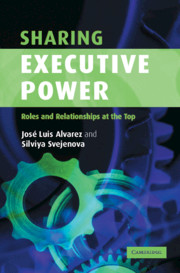Book contents
- Frontmatter
- Contents
- List of figures and tables
- Acknowledgments
- Introduction
- Part I Contingencies and roles in structuring corporate power
- Part II Small numbers at the top
- 4 Professional duos
- 5 Trios and bigger executive constellations
- 6 United careers of small numbers at the top
- Conclusion: From small numbers to corporate governance regimes
- Appendix
- References
- Index
5 - Trios and bigger executive constellations
Published online by Cambridge University Press: 22 September 2009
- Frontmatter
- Contents
- List of figures and tables
- Acknowledgments
- Introduction
- Part I Contingencies and roles in structuring corporate power
- Part II Small numbers at the top
- 4 Professional duos
- 5 Trios and bigger executive constellations
- 6 United careers of small numbers at the top
- Conclusion: From small numbers to corporate governance regimes
- Appendix
- References
- Index
Summary
I found that there were definite advantages in having a team of three at the head of the business rather than simply myself and the chief executive. It made it easier to discuss and settle issues with the chief executive, which could have been potentially divisive. If a matter has to be resolved, two people can find themselves at odds and the only solution is for one to give way to the other. This is a normal feature of coming to decisions, but it puts a strain on the relationship between the two people involved. The win/lose situation can often be avoided if a third person, in whose impartial judgement the other two have confidence, is party to the discussions.
Cadbury, 2002, p. 126Titian'sAllegory of Prudence startles the visitor to the National Gallery in London with an image of three men's heads above a triple-headed beast (wolf, lion, and dog) that hints at the three ages of man – youth, maturity, and old age. The inscription in Latin above them reads Ex praeterito praesens prvdenter agit ni futuractione detvrpet (From the past the man of the present acts prudently so as not to imperil the future). These powerful images and the message have been used as an illustration in a recent article (Pradera, 2004, p. 17) on the three-headed structure of Spain's Partido Popular (PP), a political party on the centre-right of the political spectrum, currently in opposition.
- Type
- Chapter
- Information
- Sharing Executive PowerRoles and Relationships at the Top, pp. 143 - 171Publisher: Cambridge University PressPrint publication year: 2005



